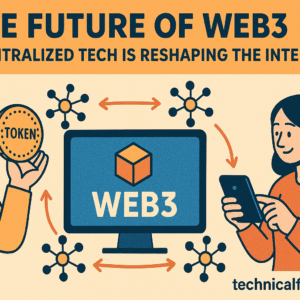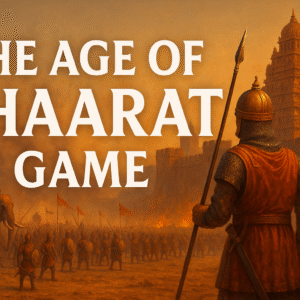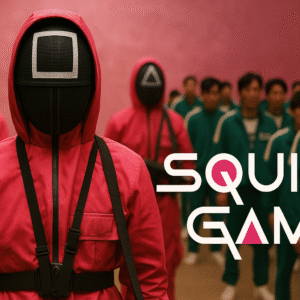Table of Contents
Imagine a world where you own all the digital art, tweets, and data you create, and no tech giant can lock you out. This is the promise of Web3 — the next phase of the internet. In The Future of Web3, users control their own data and value, not big corporations. Experts agree that Web3 means a more user-centric and secure web. Britannica defines it as a “decentralized Internet that uses blockchain technology”britannica.com to make the web more secure and private.
In this vision of The Future of Web3, your tablet or phone might feel like any other device — with one key difference: you own your data. Instead of logging into a corporate server, you connect to decentralized networks. As Brave’s guide notes, the new web will still have “familiar websites and apps” but be “more open, with no Big Tech (or government) playing gatekeeper”brave.com. In fact, Web3 browsers like Brave already block trackers and ads by defaultblockapps.net, a hint of how decentralization can put individuals at the heart of the internet.
From Web1 to the Future of Web3: A Brief Internet History
To understand where the future is headed, let’s rewind to how the web evolved:
- Web 1.0 (The Static Web): The early internet (1990s) where websites were mostly read-only pages and little user interaction was possible.
- Web 2.0 (The Social Web): The modern internet era of interactive platforms, user-generated content, and social media. Companies like Facebook, Google and Amazon run centralized services that often own and control user data.
- Web 3.0 (The Decentralized Web): The emerging phase, built on blockchain and peer-to-peer networks. In Web3, individuals own their data and can interact on platforms without centralized intermediaries. As Britannica explains, one key change is data ownership: Web3 places ownership and control of data solely with Internet usersbritannica.com, making the web more open and user-focused.
The Future of Web3: Decentralization at Its Core
At its heart, The Future of Web3 is all about decentralization. Instead of one company storing your information, Web3 runs on a network of many nodes. Britannica explains that “blockchain technology, decentralized data storage, and peer-to-peer networking are the necessary components of a decentralized Internet”britannica.com. This design has no single point of failure or gatekeeper, which can improve security and resist censorshipbritannica.com. For example, Filecoin and IPFS distribute data across many nodes instead of central serversdiadata.org, and the Helium network provides Internet access for IoT devices without traditional telecomsdiadata.org. These decentralized technologies (like blockchain ledgers and peer-to-peer protocols) underpin a Web3 internet where you can verify and own what happens online.
- Blockchain networks: Decentralized ledgers (like Ethereum or Polkadot) that keep records transparent and tamper-proof.
- Decentralized storage: Projects such as Filecoin and IPFS store files across many nodesdiadata.org.
- Peer-to-peer protocols: Systems (like Whisper or libp2p) that let users communicate and share data directly without a central server.
- Shared infrastructure networks (DePIN): Community-run systems like Helium, a blockchain-based wireless network for IoT, letting anyone provide coverage without a traditional ISPdiadata.org.
Together, these technologies make the Web3 vision possible: an open, user-powered internetweforum.org.
Ownership and Identity: Taking Back Control

Web3 isn’t just about money and code — it’s also about putting you in charge of your online identity. Instead of dozens of separate logins, imagine a world where your crypto wallet holds your identity and data. In such a world, one account could unlock every app. As one reporter put it, “In a Web3 world, people control their own data and bounce around from social media to email to shopping using a single personalized account”weforum.org.
This shift matters because users are fed up: a 2024 survey found 82% of people think major tech companies like Google and Meta already have too much power over our dataconsensys.io. Web3’s identity solutions aim to break that grip. For example, the Ethereum Name Service (ENS) lets users map simple names (like alice.eth) to their blockchain addressesdiadata.org, effectively creating a decentralized username. With tools like ENS and other decentralized IDs, the goal is to own your digital identity and decide exactly how it’s used online.
The Future of Web3 in Finance: DeFi and Tokenization
The Future of Web3’s financial ecosystem looks very different from banks and brokerages. In Decentralized Finance (DeFi), smart contracts automate lending, trading, and other transactions. Already, platforms like Uniswap let people trade crypto tokens peer-to-peer, and apps such as Compoundchangelly.com or Aave enable users to lend, earn interest or borrow without intermediaries. MakerDAO on Ethereum maintains a stablecoin (DAI) pegged to $1 by using locked collateralchangelly.com. These tools aim to replace traditional finance with transparent, code-driven markets.
- DEX (Decentralized Exchanges): Platforms like Uniswap or PancakeSwap allow peer-to-peer token trading without order books.
- Lending/Borrowing: Apps like Compoundchangelly.com and Aave let you earn yield or take loans by depositing crypto collateral.
- Stablecoins: Crypto dollars (e.g., DAI, USDC) that hold steady value for everyday crypto transactions. MakerDAO’s DAI is a key examplechangelly.com.
- Tokenized assets: Representing real-world assets (like stocks, real estate or art) as blockchain tokens, potentially broadening investment access.
Experts think this financial revolution is just beginning. One industry leader notes that “blockchain will continue to drive innovation, while new developments in decentralized finance (DeFi) … will influence how these technologies are adopted and integrated”thefintechtimes.com. As more people use Web3 wallets and DeFi apps, the global financial system could see unprecedented change.
Empowering Creators and Communities: NFTs, DAOs, and the Web3 Era
The Future of Web3 is fueling a creator revolution. Artists, musicians, gamers, and fans can trade non-fungible tokens (NFTs) — unique digital collectibles — directly with each other. For example, OpenSea is a decentralized marketplace where “transactions are conducted directly between buyers and sellers without intermediaries”changelly.com. This means a musician can sell a song as an NFT to fans without a label taking a cut, and every time that NFT is resold, the artist often earns a royalty.
Beyond individual sales, communities are organizing as DAOs (Decentralized Autonomous Organizations). In a DAO, members use tokens to vote on decisions and fund projects. Think of it as a club with transparent, code-enforced rules and a shared treasury. Fans could pool crypto to support an indie film or collectively own virtual real estate, all governed by smart contracts. These shifts give people a real stake in the digital culture they love, bypassing traditional gatekeepers.
Challenges and Criticisms: The Road Ahead for Web3
The vision of The Future of Web3 is grand, but significant hurdles remain. Today’s blockchains can be slow or costly when networks get busy, and many Web3 apps have clunky user interfaces compared to familiar Web2 services. Energy use (especially for older proof-of-work blockchains) and security issues (bugs and hacks) are also major concerns. Regulators around the world are still figuring out how to handle crypto and decentralized businesses. Even now, there’s “no universal agreement among experts” on what Web3 exactly meansweforum.org. But the effort continues, and each year brings improvements. If developers can overcome these challenges, Web3 could reshape the web in profound ways.
- Scalability: Many blockchains struggle with speed and fees under heavy use. New Layer-2 solutions and upgrades (like Ethereum’s sharding) aim to fix this, but they are works in progress.
- Usability: Managing wallets and keys can confuse new users. Web3 apps often lack the polish of Web2 platforms.
- Regulation: Governments are still crafting rules. Recent events (like exchange hacks or crypto fines) show legal risk.
- Security: Smart contract bugs and crypto scams still happen. The famous 2016 DAO hack on Ethereum taught developers hard lessons.
- Hype vs Reality: Many Web3 projects have failed or been fraudulent, and crypto markets are volatile. Skeptics warn that not all promises will pan out.
In short, building the future internet is a long journey. But as innovators keep building, we gradually see pieces of that vision come to life. The road is rocky, but the potential payoff — a fairer, more open internet — is huge.
Conclusion: The Changing Internet
Web3 is not a fully baked product yet, but it’s a powerful idea: an internet that is more open, transparent, and controlled by users. We see pieces of it today — from crypto wallets and NFTs to DAO communities and decentralized apps. According to a global survey, 93% of people are already aware of cryptocurrencies and many are trying Web3 toolsconsensys.io. Marketplaces like OpenSea have processed billions in NFT tradescointelegraph.com. These signs suggest that Web3 is more than a fad.
The Future of Web3 could bring an era where individuals have true ownership and freedom online. That might mean safer data, fairer rewards for content creators, and financial systems without borders. The road is rocky, but as innovators keep building, we may well find ourselves living in the world this vision promises. Stay curious and cautious, because the next internet might just be about to reshape our world.
The Future of Web3 is continually evolving as developers experiment and build. In the coming years, we’ll see which parts of this vision become reality and how our everyday internet will change.
Frequently Asked Questions (FAQs)
Below are answers to some common questions about Web3 and its future:
Q: What is Web3? – Web3 (sometimes called Web 3.0) refers to a decentralized version of the internet powered by blockchain and similar technologies. Unlike today’s web (Web2), where a few big companies store and control most data, Web3 gives users control. It’s an evolving concept, but at its core Web3 means a web where you manage your own identity and assets without central gatekeepersbritannica.comweforum.org.
Q: How is Web3 different from Web 2.0? – The biggest difference is who controls the data and services. In Web 2.0, platforms like social media or banks hold your data and enforce the rules. Web3 aims to decentralize that. For example, in Web3 you might log into apps with a blockchain wallet instead of a username/password, and transactions happen via smart contracts rather than a company’s databasebritannica.combrave.com.
Q: Are cryptocurrencies and NFTs part of Web3? – Yes. Cryptocurrencies (like Bitcoin or Ethereum) are the first major Web3 applications, providing decentralized money. NFTs (non-fungible tokens) are unique digital items on the blockchain, used for art, collectibles, real estate and more. They demonstrate how value and ownership can be tracked on-chain. Both crypto and NFTs show practical uses of Web3 concepts: decentralization, digital ownership, and peer-to-peer exchangecointelegraph.comchangelly.com.
Q: How can I start using Web3? – To explore Web3, you can start by setting up a crypto wallet (like MetaMask). Then you can buy a small amount of cryptocurrency and try simple decentralized apps (dApps) such as a Web3 game, an NFT marketplace, or a DeFi platform. Remember to only use trusted services and never share your private keys. It’s wise to read guides and proceed carefully since blockchain transactions are irreversible.
Q: What are the benefits of Web3 for everyday users? – Web3 could give you more control over your data and digital property. You might not need to trust big corporations as much, because trust comes from code (smart contracts). This could mean better privacy, new ways to earn (like getting paid for your data or content), and financial access without banks (via DeFi). Of course, it’s still early days and usability needs to improve for these benefits to be seamless.
Q: Will Web3 replace the current internet? – Not overnight. Web3 is more likely to coexist and gradually integrate with the current Web2 internet. We will probably use a hybrid of both for some time. Over years, more websites and services may adopt Web3 features (decentralized logins, token payments, etc.). Many parts of the internet (like video streaming or email) might still run on traditional servers for a while. The goal is to add new functionality, not to instantly tear down the old web.
Q: What does The Future of Web3 hold? – It means an internet where you truly own your data and digital items, not just use them. We can expect familiar apps with blockchain “under the hood”: social networks where you control your profile data, games with player-owned items, and finance tools run by code instead of banks. Many experts also predict Web3 will blend with AI and real-world devices, creating smarter, decentralized servicesmedium.com. In short, the future of Web3 is expected to gradually reshape how we interact online, giving individuals more control over their digital lives.




Leave a Reply